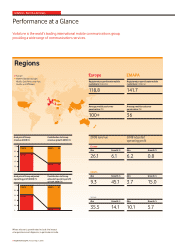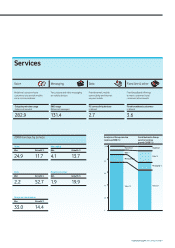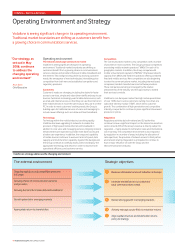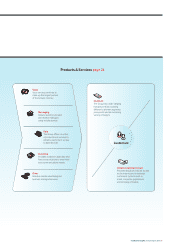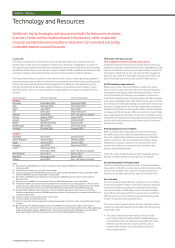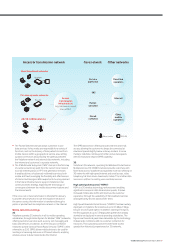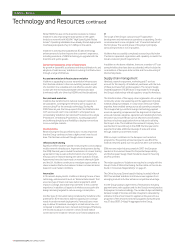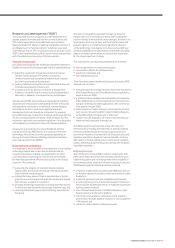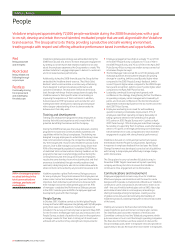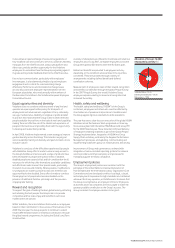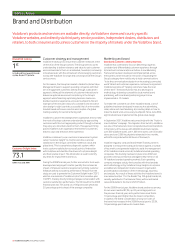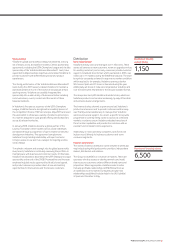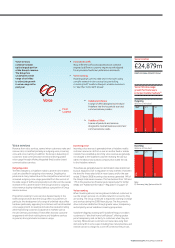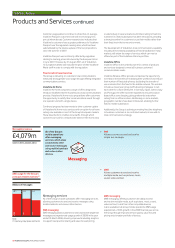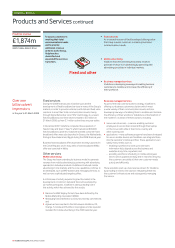Vodafone 2008 Annual Report Download - page 20
Download and view the complete annual report
Please find page 20 of the 2008 Vodafone annual report below. You can navigate through the pages in the report by either clicking on the pages listed below, or by using the keyword search tool below to find specific information within the annual report.
Technology and Resources continued
While HSDPA focuses on the downlink (network to mobile),
Vodafone is also improving the data speeds on the uplink
(mobile to network) with HSUPA (“High Speed Uplink Packet
Access”). Operating subsidiaries have already started deployments
to achieve peak speeds of up to 1.4 Mbps on the uplink.
Vodafone is actively driving additional 3G data technology
enhancements to further improve the customer’s experience,
including evolutions of HSPA technology to upgrade both the
downlink and uplink speeds.
Current developments in the infrastructure
As growth in data traffic accelerates with the proliferation in, and
adoption of, web services, Vodafone is evolving its infrastructure
through a range of initiatives.
Access transmission infrastructure evolution
Vodafone is upgrading its access transmission infrastructure
from the base stations to the core switching network as part
of a transition to a scaleable and cost effective solution able
to deal with the increasing bandwidth demands and data
dominated traffic mix driven by HSDPA and fixed broadband.
Core network evolution
Vodafone has transformed its national transport networks in
all subsidiaries, converging the infrastructure to support all
services using IP as the strategic technology. During the
2009 financial year, the Group expects that the transformation
to IP services will start to be extended to a European level,
consolidating Vodafone’s ten national IP networks into a single
IP backbone, centralising IP operations, avoiding duplication
and achieving simplicity and flexibility to deploy new services
to serve multiple markets.
Cost reduction
While evolving the Group’s infrastructure, it is also important
that the Group continues to have a tight control over its cost
base. This has been achieved through various measures.
Infrastructure sharing
Significant effort has been placed in reducing the costs to deploy
mobile network infrastructure. Important developments during
the 2008 financial year included the extension of a tower sharing
agreement in Italy as well as the formation of a company for
the purposes of network sharing with other operators in India.
Agreements have also been made on network sharing in Spain
and the UK. Vodafone continues to investigate opportunities to
share network infrastructure where it makes commercial sense
based on local market conditions.
Innovation
In 3G network deployments, Vodafone is driving the use of new
technology enhancements such as “Remote Radio Heads” that
are a new type of lower cost base station equipment, which
improve coverage and enable improvements to the customer
experience. In addition, all aspects of wireless access point site
design are being targeted to reduce energy consumption.
Another type of innovation being considered by Vodafone is the
potential for 3G femtocells to address capacity and coverage
needs in certain network deployments. Femtocells are a new
way to deliver 3G wireless coverage to a small area at low cost
compared to traditional macro network technologies. Effectively,
a femtocell would give a customer a small 3G base station
connected to the Vodafone network via a fixed broadband line.
IT
The scope of the Group’s outsourcing of IT application
development and maintenance operations is expanding. Service
commencement is now complete in all 12 selected markets of
the first phase. The second phase of the project, principally
outsourcing to India, is now in progress.
Vodafone has successfully completed outsourcing of its Indian
IT estate to a specialist organisation with capability to match the
Group’s scale and growth requirements.
In addition to the above initiatives, there are a number of IT cost
saving initiatives that have been accelerated, which include the
consolidation of European data centres and the outsourcing of
internal help desks.
Supply chain management
Handsets, network equipment, marketing and IT services
account for the majority of Vodafone’s purchases, with the bulk
of these purchases from global suppliers. The Group’s Supply
Chain Management (“SCM”) team is responsible for managing
the Group’s relationships with all suppliers, except for handsets.
The transformation of the supply chain organisation into a single
community under one leadership and the application of global
material category strategies, in conjunction with local market
expertise, have enabled savings across all operating companies.
This is supported by a uniform savings methodology applied
across all operating companies and the alignment of objectives
across all material categories, operations and enabling functions.
Innovative sourcing methods such as eAuctions and seamless
business to business applications form a vital part in utilising
the Group’s scale. The Vodafone Procurement Company S.a.r.l.
was founded in Luxembourg in the 2008 financial year and is
expected to enable additional leverage of scale and scope
through a leaner procurement model.
SCM is a major contributor to the European cost reduction
programme. The publicly announced goal to save 8% of the
external networks spend over two years has been overachieved.
SCM won two major industry awards in 2007: the European
Leaders in Procurement Award for Corporate Responsibility
and the European Supply Chain Excellence Award in Sourcing
and Procurement.
The major suppliers to Vodafone are required to comply with the
Group’s Code of Ethical Purchasing. Further detail on this can be
found in “Corporate Responsibility” on page 61.
The China Sourcing Centre based in Beijing, founded in March
2007, has enabled Vodafone to introduce new suppliers from
emerging markets to further enhance competitive advantage.
It is the Group’s policy to agree terms of transactions, including
payment terms, with suppliers and it is the Group’s normal practice
that payment is made accordingly. The number of days outstanding
between receipt of invoices and date of payment, calculated by
reference to the amount owed to suppliers at the year end as a
proportion of the amounts invoiced by suppliers during the year,
was 37 days (2007: 34 days) in aggregate for the Group.
18 Vodafone Group Plc Annual Report 2008
Vodafone – Business


